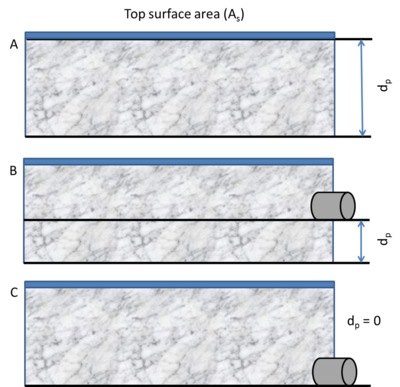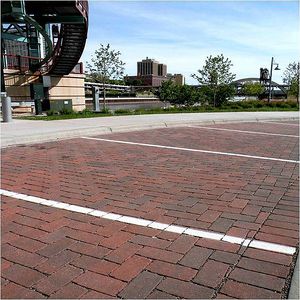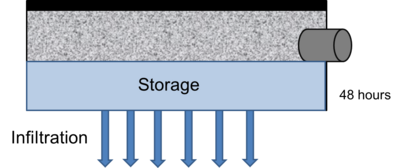
Difference between revisions of "Calculating credits for permeable pavement"
m (→Volume credits) |
m (→Volume credits) |
||
| Line 27: | Line 27: | ||
[[File:Design schematic 3.png|thumb|400px|alt=schematic showing storage and infiltration below an elevated underdrain.|<font size=3>Schematic showing storage and infiltration below an elevated underdrain. Infiltration must occur with 48 hours. If the underdrain was placed at the bottom of the design, there would be no storage credit but an infiltration credit can be received.</font size>]] | [[File:Design schematic 3.png|thumb|400px|alt=schematic showing storage and infiltration below an elevated underdrain.|<font size=3>Schematic showing storage and infiltration below an elevated underdrain. Infiltration must occur with 48 hours. If the underdrain was placed at the bottom of the design, there would be no storage credit but an infiltration credit can be received.</font size>]] | ||
| + | |||
Often, permeable pavement will be designed to meet a specific performance goal, such as the 1.1 inch Minimal Impact Design Standards (MIDS) goal for new development sites with no restrictions or a [[Acronyms|TMDL]] goal for phosphorus or TSS reductions. Specifications for designing permeable pavement systems, including a discussion of how to calculate the reservoir depth, are provided in the section covering [[Design specifications for permeable pavement|design specifications for permeable pavement]]. When an underdrain exists at the bottom of the permeable pavement system, the reservoir depth equals zero and there is no storage credit. | Often, permeable pavement will be designed to meet a specific performance goal, such as the 1.1 inch Minimal Impact Design Standards (MIDS) goal for new development sites with no restrictions or a [[Acronyms|TMDL]] goal for phosphorus or TSS reductions. Specifications for designing permeable pavement systems, including a discussion of how to calculate the reservoir depth, are provided in the section covering [[Design specifications for permeable pavement|design specifications for permeable pavement]]. When an underdrain exists at the bottom of the permeable pavement system, the reservoir depth equals zero and there is no storage credit. | ||
Revision as of 23:10, 5 February 2013
The anticipated construction period for this page is January through March, 2013
The anticipated review period for this page is January through March, 2013
Permeable pavement is a tool that can achieve reductions in stormwater volume and pollutant loading, thereby generating stormwater credits. Permeable pavement will achieve the greatest credit when it is properly designed, constructed and maintained.
This section provides specific information on generating and calculating credits from permeable pavement for volume, TSS and phosphorus. Permeable pavement may also be effective at reducing concentrations of other pollutants such as metals and nitrogen. This article does not provide information on calculating credits for pollutants other than TSS and phosphorus, but references are provided that may be useful for calculating credits for these other pollutants.
In high-infiltration rate soil subgrades, permeable pavement can be designed without an underdrain. When sized to capture all rain events with no overflow ever occurring, this design retains 100% of the annual runoff volume and 100% of annual pollutant loading. Permeable pavements will typically be built to meet other performance goals. For example, when designing for the MIDS performance goal for new development in sites without restrictions, the pavement must infiltrate the first 1.1 inches of rainfall.

Contents
- 1 Volume credits
- 2 TSS credits
- 3 Phosphorus credits
- 3.1 Models and calculators for calculating permeable pavement Phosphorus credits
- 3.2 Assumptions and factors affecting phosphorus credits for permeable pavement
- 3.3 Literature review on phosphorus reductions for permeable pavement
- 3.4 Recommended values for phosphorus reductions from permeable pavement
- 4 Example applications for calculating permeable pavement credits for volume, TSS and phosphorus
- 5 Pollutants other than TSS and phosphorus
- 6 Volume credits
- 6.1 Equations and design criteria
- 6.2 Models and calculators for calculating permeable pavement volume credits
- 6.3 Assumptions and factors affecting volume credits for permeable pavement
- 6.4 Literature review on volume reductions for permeable pavement
- 6.5 Recommended values for volume reductions from permeable pavement
- 7 TSS credits
- 8 Phosphorus credits
- 8.1 Models and calculators for calculating permeable pavement Phosphorus credits
- 8.2 Assumptions and factors affecting phosphorus credits for permeable pavement
- 8.3 Literature review on phosphorus reductions for permeable pavement
- 8.4 Recommended values for phosphorus reductions from permeable pavement
- 9 Example applications for calculating permeable pavement credits for volume, TSS and phosphorus
- 10 Pollutants other than TSS and phosphorus
Volume credits
A permeable pavement system achieves volume reductions through storage of water in a reservoir beneath the permeable pavement surface and through infiltration into the underlying soil. The overall credit will be the sum of the storage and infiltration credit.
- Storage credit
The storage credit is a function of the design and dimensions of the permeable pavement system, specifically the depth of the subbase below an underdrain, the area of permeable pavement and the porosity of the subbase. The storage credit (Vs) is given by
\(V_s = A_s d_p n\)
where
- As = the surface area of the permeable pavement system (square feet);
- dp = the depth of the reservoir layer, equal to the area from the bottom of the underdrain to the underlying soil (do not include the surfacing thickness)(feet); and
- n = porosity of the subbase(cubic feet/cubic feet)
Often, permeable pavement will be designed to meet a specific performance goal, such as the 1.1 inch Minimal Impact Design Standards (MIDS) goal for new development sites with no restrictions or a TMDL goal for phosphorus or TSS reductions. Specifications for designing permeable pavement systems, including a discussion of how to calculate the reservoir depth, are provided in the section covering design specifications for permeable pavement. When an underdrain exists at the bottom of the permeable pavement system, the reservoir depth equals zero and there is no storage credit.
- Infiltration credit
For a design with no underdrain, an infiltration credit can also be given if the reservoir storage area is exceeded during a rain event. This is a complicated calculation since infiltration will occur while the reservoir is filling. An approximation of the volume infiltrated (Vi) is given by
\(V_i = A_s i/2 t_f\)
where
- i = the soil infiltration rate (feet/day);
- tf = the time it takes to fill the reservoir layer (day); and
- 2 is a safety factor
In low-infiltration soils where the design will most likely include an underdrain, some infiltration of water into the subgrade occurs. The volume of water infiltrated depends on the volume of storage available below the underdrain outflow invert. The remaining filtered runoff is collected in the underdrain and exits to the storm drainage system, typically a stream or storm sewer. Equations provided in the section providing design specifications for permeable pavement can be used to calculate outflow volumes through underdrains. It is recommended that i be field verified. A typical value for tf is 2 hours (0.083 day).
Assumptions and factors affecting volume credits for permeable pavement
The following general assumptions apply in calculating the credit for permeable pavement. If any of these assumptions is violated, the credit will be reduced.
- The permeable pavement is properly designed.
- The permeable pavement was properly constructed, consistent with the design criteria.
- The permeable pavement is properly maintained. The performance of the permeable pavement should be regularly assessed.
Assumptions used to calculate credits may also vary with each calculator or model. To calculate credits it is important to ensure that your calculation is consistent with the assumptions made in the model or calculator you are using. Assumptions for each model or calculator are briefly discussed below. More detailed discussions of assumptions may be found in user's manuals or other documentation for the model or calculator.
Models and calculators for calculating permeable pavement volume credits
There are many models and calculators that can be used to calculate volume reductions associated with use of permeable pavement, including the following:
- MIDS calculator. The MIDS calculator will deliver the credit as a volume reduction and will provide a comparison with the MIDS performance goal of 1.1 inches of runoff retained.
Literature review on volume reductions for permeable pavement
Table X summarizes information on volume reductions achieved with permeable pavement. Below is a list of literature sources for this information. The literature articles contain additional information regarding the values cited in Table X. We include a short overview for some of the references.
Recommended values for volume reductions from permeable pavement
TSS credits
Models and calculators for calculating permeable pavement TSS credits
The following models or calculators can be used to calculate the credit:
Assumptions and factors affecting TSS credits for permeable pavement
Literature review on TSS reductions for permeable pavement
Recommended values for TSS reductions from permeable pavement
Phosphorus credits
Models and calculators for calculating permeable pavement Phosphorus credits
The following models or calculators can be used to calculate the credit:
Assumptions and factors affecting phosphorus credits for permeable pavement
Literature review on phosphorus reductions for permeable pavement
Recommended values for phosphorus reductions from permeable pavement
Example applications for calculating permeable pavement credits for volume, TSS and phosphorus
Pollutants other than TSS and phosphorus
In addition to TSS and phosphorus, permeable pavement can reduce loading of the following pollutants:
- Metals such as copper and zinc
- Nitrogen
- Hydrocarbons
- Chloride (indirectly by reducing the amount of road salt applied)
- Oxygen demand
Specific credits and methods for calculating credits are not provided in this section. Information on removal of these pollutant by permeable pavement systems can be found at the following links.
- [1] - information on zonc, copper, lead, nitrate, Kjeldahl nitrogen, and total nitrogen
- [2] - information on total nitrogen, heavy metals, and hydrocarbons.
NOTE - WHAT ARE WE GOING TO SAY ABOUT INFILTRATION CREDIT Table X.3 specifies how to estimate the volume of reservoir storage required for this performance goal. In low-infiltration soils where the design will most likely include an underdrain, some infiltration of water into the subgrade occurs. The volume of water infiltrated depends on the volume of storage available below the underdrain outflow invert. The remaining filtered runoff is collected in the underdrain and exits to the storm drainage system, typically a stream or storm sewer. This design may reduce some outflow from the pavement base. Such designs offer some treatment of pollutants. The volume and pollutant reductions for permeable pavement listed in Table X.1 correspond (MIDS calculator. A project can be recognized for higher pollutant reductions if demonstrated by the project designer. Besides adequate design and construction, maintenance is critical to permeable pavement performance. All three aspects must be demonstrated for each project in order to qualify for the stated credits.
Information in this article is intended to aid in determining the best method for calculating credits and to lead the user to the appropriate resources for calculating credits. While it may be desirable to establish specific values that can be used to calculate credits, this prevents flexibility and does not allow for consideration of the range of factors that affect the volume or pollutant reductions associated with any one BMP.
There are several potential reasons for calculating credits. It is important to identify the reasons for calculating a credit and the information and resources available for calculating credits. In some cases it may be appropriate to use simple spreadsheet calculations, while in other cases more sophisticated modeling may be warranted.
This article provides users with basic equations used in calculating credits, suggests some models that may be used to calculate credits, and presents information on BMP performance that can also be used to calculate credits. The user will ultimately have to choose the most appropriate method.
Volume credits
The amount of credit given for volume reduction is a function of the design and performance (construction and maintenance) of the permeable pavement system.
Equations and design criteria
The credit is given by the following equation
V = As * Do * n
where V is volume of storage (ft3), As is the area of permeable pavement (ft2), Do is the depth from the underdrain outflow pipe to the soil subgrade (ft.; not including surfacing thickness), and n is the porosity of stone per ASTM C29 or AASHTO T-19 (decimal). If there is no underdrain, the equation becomes
V = As * D * n
where D is the depth of base /subbase (ft. not including surfacing thickness). This credit assumes no infiltration of water stored in the permeable pavement system. Infiltration will increase the credit.
Models and calculators for calculating permeable pavement volume credits
There are many models and calculators that can be used to calculate volume reductions associated with use of permeable pavement, including the following:
- MIDS calculator. The MIDS calculator will deliver the credit as a volume reduction and will provide a comparison with the MIDS performance goal of 1.1 inches of runoff retained.
Assumptions and factors affecting volume credits for permeable pavement
Assumptions used to calculate credits may vary with each calculator or model. To calculate credits it is important to ensure that your calculation is consistent with the assumptions made in the model or calculator you are using. Assumptions for each model or calculator are briefly discussed in the previous sub-section. More detailed discussions of assumptions may be found in user's manuals or other documentation for the model or calculator. The following general assumptions apply in calculating the credit for permeable pavement. If any of these assumptions is violated, the credit will be reduced.
- The permeable pavement is properly designed. Credits can be adjusted using the equations presented in the design section for permeable pavement. Factors that will influence adjustments to the credit calculation include the depth of runoff from the contributing drainage area (not including the permeable paving surface) for the design storm, the ratio of the contributing drainage area (not including the permeable paving surface) to the permeable pavement surface area, the rainfall depth for the treatment volume, the field-verified infiltration rate for native soils, the time to fill the reservoir layer, and the void ratio for the reservoir layer (0.4).
- The permeable pavement was properly constructed, consistent with the design specifications.
- The permeable pavement is properly maintained. The performance of the permeable pavement should be regularly assessed.
Literature review on volume reductions for permeable pavement
Table X summarizes information on volume reductions achieved with permeable pavement. Below is a list of literature sources for this information. The literature articles contain additional information regarding the values cited in Table X. We include a short overview for some of the references.
Recommended values for volume reductions from permeable pavement
TSS credits
Models and calculators for calculating permeable pavement TSS credits
The following models or calculators can be used to calculate the credit:
Assumptions and factors affecting TSS credits for permeable pavement
Literature review on TSS reductions for permeable pavement
Recommended values for TSS reductions from permeable pavement
Phosphorus credits
Models and calculators for calculating permeable pavement Phosphorus credits
The following models or calculators can be used to calculate the credit:
Assumptions and factors affecting phosphorus credits for permeable pavement
Literature review on phosphorus reductions for permeable pavement
Recommended values for phosphorus reductions from permeable pavement
Example applications for calculating permeable pavement credits for volume, TSS and phosphorus
Pollutants other than TSS and phosphorus
In addition to TSS and phosphorus, permeable pavement can reduce loading of the following pollutants:
- Metals such as copper and zinc
- Nitrogen
- Hydrocarbons
- Chloride (indirectly by reducing the amount of road salt applied)
- Oxygen demand
Specific credits and methods for calculating credits are not provided in this section. Information on removal of these pollutant by permeable pavement systems can be found at the following links.

